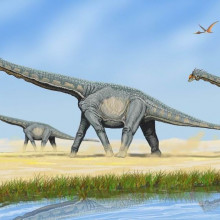This week, a farm worker in Argentina stumbled upon what has turned out to be a bone belonging to the largest known dinosaur to have ever walked the planet. Here's your Quick Fire Science on the find, with Kate Lamble and Dave Ansell...
In this episode

00:00 - World's Largest Dinosaur
World's Largest Dinosaur
This week, a farm worker in Argentina stumbled upon what has turned out to be a bone belonging to the largest known animal to have ever walked the planet. Here's your Quick Fire Science on the find... 
- The creature is a type of dinosaur known as a sauropod, and related to the previous contender for the 'biggest dinosaur' title, the Argentinosaurus.
- Sauropods like this new dinosaur and it's famous relative the Diplodocus, had large bodies, long necks and tails, and very small heads.
- The newly discovered sauropod is thought to be 40m long and 20 m tall - the height of a 7 story building.
- It weighed 77 tonnes which makes it as heavy as 14 African elephants.
- The animal was a herbivore, and lived during the late Cretaceous period - 100 million years ago.
- Scientists think that sauropods grew so big because being bigger may have helped them fend or scare off predatory dinosaurs.
- They had long necks which allowed them to reach many different food sources to fuel their large bodies, and light bones which helped them to overcome structural constraints.
- This discovery is particularly important as they have found 150 bones, from 7 individuals, which are said to be in 'remarkable' condition.
- Previously, researchers have only had a few bones to go on, making it difficult to estimate the size and weight of the creature.
- The weight of the previous contender, Argentinosaurus was revised down from the initial estimate of 100 tonnes to 70, because estimating weight from so few bones is unreliable.
- It can also be difficult to work out the dinosaurs' proportions and overall shape when not all the bones are present.
- This dinosaur hasn't yet been named- but researchers have said the name will honour the region it was found, and the farm workers who made the discovery.
- Previous Melatonin: Chemistry in its element
- Next Addressing Autism










Comments
Add a comment